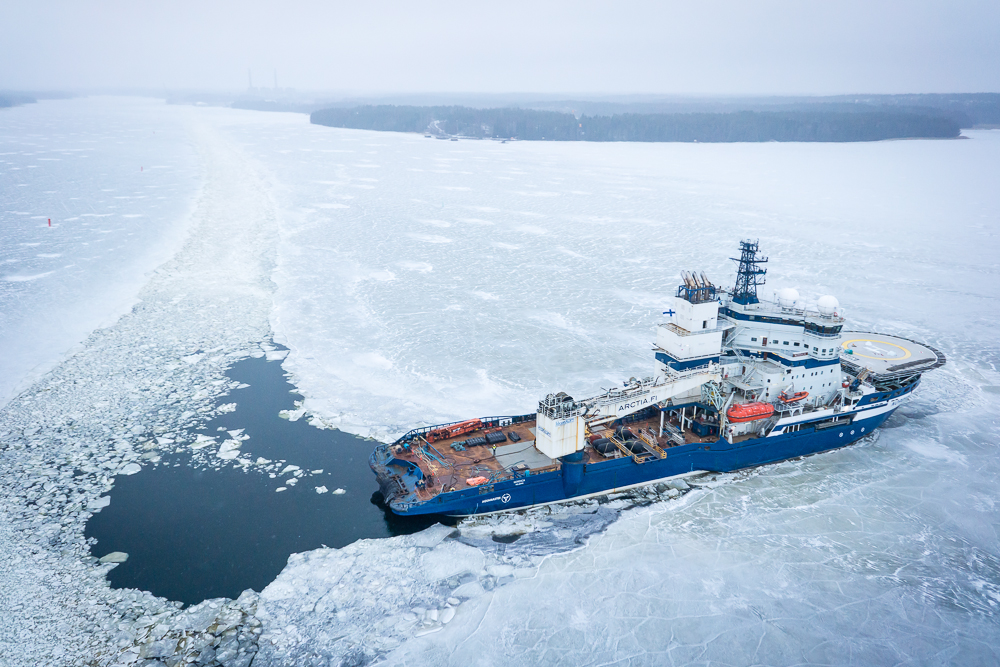Can the US benefit from Finland and Russia’s icebreaker expertise?

Finland, the world leader in icebreaker design and construction, could help pull the United States out of its icebreaker crisis, a diplomat said at a business conference in Anchorage last week.
“The U.S. is now in dire straits about its own icebreaker fleet. They only have two and they are both seriously outdated. We can help,” Stefan Lindstrom, Finland’s Los Angeles-based consul general, said in a presentation at last week’s Arctic Ambitions conference held by the World Trade Center of Alaska.
Lindstrom was referring to the Healy and the Polar Star, the entirety of the U.S. Coast Guard’s fleet of active polar-capable icebreakers.
If the U.S. makes a decision to buy a replacement from overseas, Finnish shipbuilders could respond quickly, Lindstrom said.
In Finland, a shipyard can build and deliver a polar-class icebreaker within 24 months after a contract is signed — a sharp contrast, Lindstrom said, to the extended discussions that the U.S. Coast Guard and Congress have had over planning for potential new icebreakers.
And the costs for a Finnish-designed and Finnish-built polar-class icebreaker is about 200 million to 220 million Euros ($235 to 258 million), he said. That’s far lower than the price tag being discussed in the US.
“I have serious difficulties, however, understanding how you can pay a billion for an icebreaker that costs one-fifth of it if you order it from abroad,” Lindstrom said. “But I’m not going to go into those political situations.”
The “billion” refers to estimates given by U.S. officials about what a new icebreaker will cost. (An August report by the Congressional Research Service that addresses new icebreaker costs suggested that if all three planned new vessels are built as a package at a single shipyard, there might be a savings of $200 million.)
Lindstrom raised the idea of leasing a Finnish icebreaker as an option for the U.S., and others have made the similar suggestions. But the U.S. Coast Guard has been cool to that idea, and U.S. politicians have routinely panned the idea of buying an icebreaker from another country.
The sticking point may be the Jones Act, also known as the Merchant Marine Act of 1920. The law requires that all cargo or passenger ship transport between domestic U.S. ports be on U.S.flagged vessels. Even though Alaska is not connected to the rest of the nation by land, shipping to its ports remains subject the Jones Act.
If political obstacles are overcome, Lindstrom said, the U.S. could benefit from Finland’s icebreaker technology.
About 60 percent of icebreakers ever built in the world are built in his country, and about 80 percent of the breakers have been designed there, he said. “We are really the icebreaker superpower. There’s no question about that.”
Lindstrom ticked off the accomplishments of the industry and its long history, which dates back to the late 19th century. He dug up film footage of a 1920s-era icebreaker plowing through the ice near Helsinki, with an excited crowd of people just a few feet away from the hull as it crashes through the ice.
https://www.youtube.com/watch?v=xIcztFpx99c
Icebreaker technology has made tremendous advances since then, and the U.S. could benefit from them, Lindstrom said.
“Modern technology has an edge when you’re talking about icebreakers, and you really need to know what you’re doing,” he said.
The icebreakers have sophisticated propeller systems, with angled positions that allow for nimble direction changes.
One of them, the Nordica, went through the Northwest Passage in 24 days in July. The crossing itself was “something that not many ships and not many people have been able to doing for hundreds and hundreds of years” Lindstrom said. More remarkable was the early date of that the voyage was completed — the earliest on record for that once-ice-clogged route — and the speed with which it was done.
The newest Finnish icebreaker vessel — the Polaris, launched last year — is the world’s first LNG-powered icebreaker. “You can’t get more environmentally friendly than that,” Lindstrom said. It is also Finland’s most powerful icebreaker, and it can move at 6.2 knots in 1.2-meter ice, compared to the Healy’s top speed of 4 knots in such ice, Lindstrom said.
[World’s first LNG icebreaker set to go into service]
Russia also has advanced icebreaker technology, as described by Andrey Bondarev, head of the economic section at the Russian Embassy in Washington.
The first of three new nuclear-powered icebreakers in a program called Project 22220 was launched in 2016. The second, the Sibir (or “Siberia”) was launched in September. The third, the Ural, is under construction. The three icebreakers, once in operation, will be the most powerful in the world.
Bondarev, who spoke to the conference by Skype, described the icebreakers as highly flexible.
“They are very unique, because it’s like two in one. They have variable draft, both for high seas and shallow rivers and shallow Arctic waters,” he said.
And the next batch of icebreakers will twice as powerful as those built under project 22220, Bondarev said. The new icebreakers will be able to go through ice more than 4 meters thick, he said. Their primary purpose will be to escort oil and LNG tankers from new Arctic projects, he said. “The construction of this specific more powerful type of vessel should be lining up with major Arctic oil and gas projects by 2025,” he said.
The new Russian icebreakers are impressive, Paul Fuhs, president of the Marine Exchange of Alaska, said at the conference.
He said advocates of more U.S. icebreakers should push for propeller arrangements that, like those in Russia and Finland, allow movement in any direction.
“This is what we ought to be looking for as we look for the U.S. to build icebreakers,” Fuhs said.